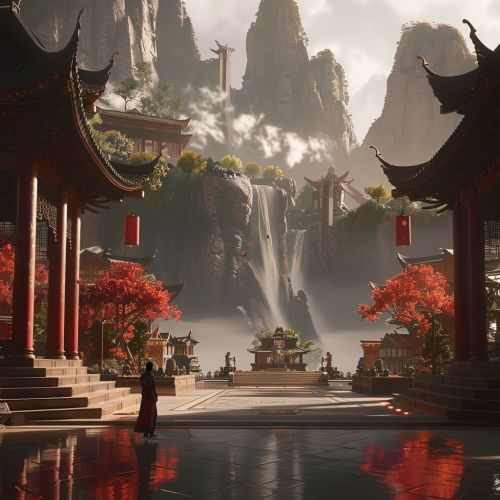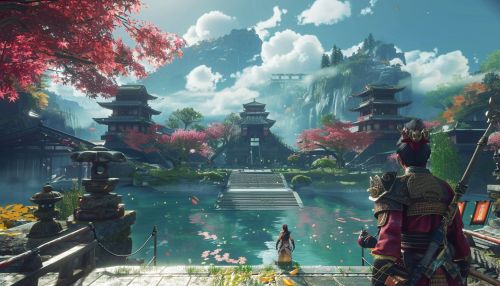Cutscenes
Introduction
Cutscenes are a fundamental component of video games that serve to advance the plot, develop characters, and provide players with a deeper understanding of the game world. These scripted sequences can vary widely in their execution, ranging from simple text-based dialogues to complex, cinematic experiences. Cutscenes play a crucial role in bridging gameplay segments, offering narrative context, and enhancing the overall immersive experience.
History
The concept of cutscenes dates back to the early days of video gaming. One of the earliest examples can be found in the 1980 arcade game Pac-Man, which featured brief intermissions between levels. These intermissions, though simple, provided a rudimentary form of storytelling.
As technology advanced, so did the complexity and sophistication of cutscenes. The 1987 game The Legend of Zelda introduced more elaborate cutscenes that helped to establish the game's narrative. By the 1990s, with the advent of CD-ROM technology, games like Final Fantasy VII and Metal Gear Solid pushed the boundaries of what cutscenes could achieve, incorporating high-quality pre-rendered videos and voice acting.
Types of Cutscenes
Cutscenes can be broadly categorized into several types, each serving a distinct purpose within a game:
Pre-rendered Cutscenes
Pre-rendered cutscenes are created using computer-generated imagery (CGI) and are often used to depict complex scenes that would be difficult to render in real-time. These cutscenes are typically of higher visual quality and are used to convey important plot points or dramatic moments.
In-engine Cutscenes
In-engine cutscenes are rendered using the game's graphics engine, allowing for a seamless transition between gameplay and narrative sequences. These cutscenes can be more dynamic, as they can incorporate the player's character and actions into the scene.
Interactive Cutscenes
Interactive cutscenes, also known as Quick Time Events (QTEs), require player input to progress. These cutscenes blend narrative and gameplay, often involving timed button presses or other actions to influence the outcome of the scene.
Live-action Cutscenes
Live-action cutscenes use real actors and sets to create cinematic sequences. This approach was popularized in the 1990s with games like Command & Conquer and Wing Commander IV. While less common today, live-action cutscenes can provide a unique and immersive experience.
Functions of Cutscenes
Cutscenes serve multiple functions within a game, enhancing the player's experience in various ways:
Narrative Development
Cutscenes are a primary tool for advancing the game's story. They provide context, introduce new characters, and reveal plot twists. By controlling the pacing and presentation of the narrative, cutscenes ensure that key story elements are delivered effectively.
Character Development
Through cutscenes, developers can delve deeper into character motivations, relationships, and backstories. This helps to create more relatable and engaging characters, fostering a stronger emotional connection between the player and the game world.
World-building
Cutscenes contribute to the game's world-building by showcasing environments, cultures, and lore. They can provide historical context, explain the significance of certain locations, and immerse players in the game's setting.
Emotional Impact
Well-crafted cutscenes can evoke a wide range of emotions, from excitement and joy to sadness and fear. By using cinematic techniques such as music, camera angles, and voice acting, cutscenes can create powerful emotional experiences that resonate with players.


Techniques and Technologies
The creation of cutscenes involves a combination of artistic and technical skills. Several techniques and technologies are employed to produce high-quality cutscenes:
Motion Capture
Motion capture (mocap) technology is used to record the movements of actors, which are then applied to digital characters. This technique allows for more realistic and fluid animations, enhancing the believability of the characters and their actions.
Voice Acting
Voice acting adds depth and personality to characters, making them more relatable and engaging. Professional voice actors bring characters to life, conveying emotions and nuances that text alone cannot achieve.
Cinematography
Cinematography techniques, such as camera angles, lighting, and shot composition, are used to create visually compelling cutscenes. These techniques help to guide the viewer's attention, emphasize important elements, and enhance the overall storytelling.
Sound Design
Sound design plays a crucial role in cutscenes, providing auditory cues that complement the visual elements. Music, sound effects, and ambient noises work together to create an immersive and emotionally resonant experience.
Challenges and Criticisms
While cutscenes are a valuable storytelling tool, they are not without their challenges and criticisms:
Disruption of Gameplay
One common criticism of cutscenes is that they can disrupt the flow of gameplay. Long or frequent cutscenes may interrupt the player's immersion and sense of agency, leading to frustration.
Passive Experience
Cutscenes are often criticized for being a passive experience, where players have little to no control over the events unfolding on screen. This can be seen as a departure from the interactive nature of video games.
Over-reliance
Some games are criticized for over-relying on cutscenes to convey their story, at the expense of interactive storytelling. This can result in a disjointed experience, where the narrative feels disconnected from the gameplay.
Innovations and Future Trends
The future of cutscenes is likely to be shaped by advancements in technology and evolving player expectations. Several trends and innovations are emerging in the field:
Real-time Ray Tracing
Real-time ray tracing technology allows for more realistic lighting and reflections in cutscenes, enhancing visual fidelity. This technology is becoming increasingly accessible with the latest generation of gaming hardware.
Virtual Reality
Virtual reality (VR) offers new possibilities for cutscenes, allowing players to experience narrative sequences in a fully immersive 3D environment. VR cutscenes can provide a greater sense of presence and agency, blurring the line between gameplay and storytelling.
Procedural Generation
Procedural generation techniques can be used to create dynamic and adaptive cutscenes that respond to player choices and actions. This can lead to more personalized and varied narrative experiences.
Conclusion
Cutscenes are an integral part of modern video games, offering a powerful means of storytelling and immersion. While they present certain challenges, their ability to convey complex narratives, develop characters, and evoke emotions makes them an invaluable tool for game developers. As technology continues to advance, the potential for innovative and engaging cutscenes will only grow, further enriching the gaming experience.
